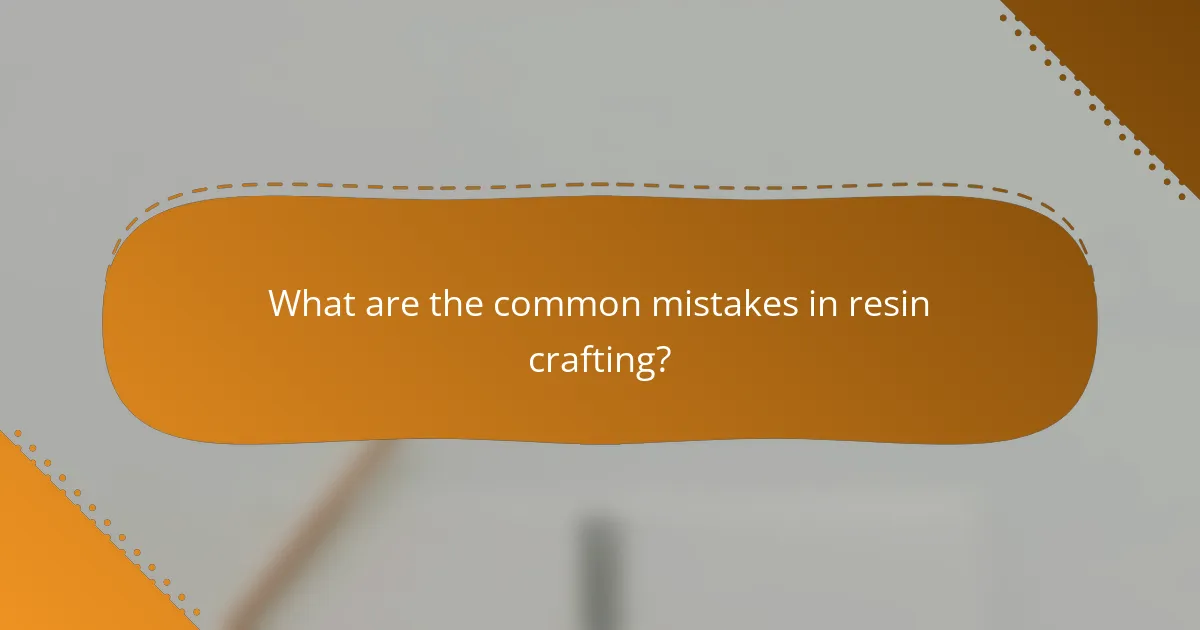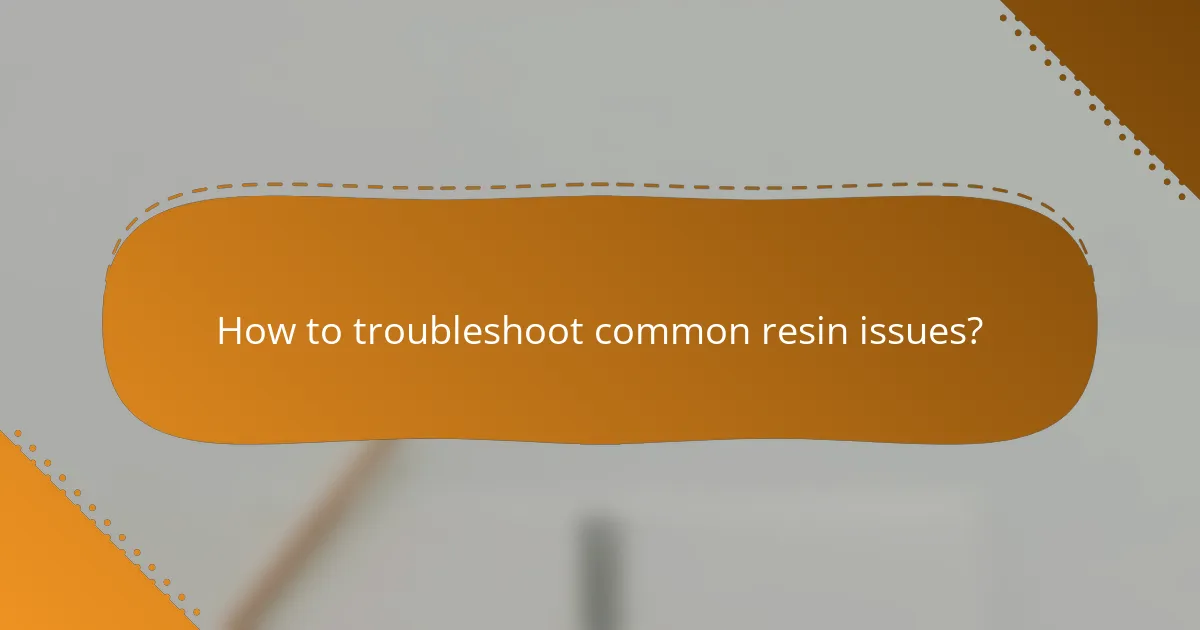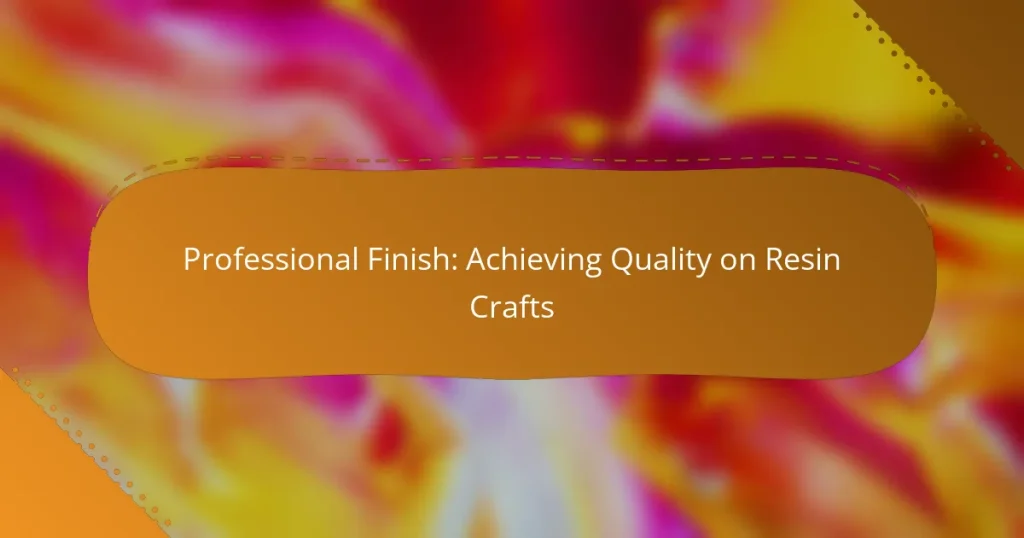Achieving a professional finish on resin crafts requires attention to detail and the use of high-quality materials. By mastering proper preparation, mixing, and finishing techniques, you can ensure a smooth and glossy result that enhances the overall quality of your projects.

How to achieve a professional finish on resin crafts?
To achieve a professional finish on resin crafts, focus on using high-quality materials and techniques. Proper preparation, mixing, and finishing processes are essential for a smooth and glossy result.
Use high-quality resin brands
Selecting high-quality resin brands is crucial for achieving a professional finish. Premium resins often have better clarity, UV resistance, and lower chances of bubbles or imperfections. Look for brands that are well-reviewed and specifically designed for crafting.
Consider resins that are formulated for your specific project type, whether it’s casting, coating, or art applications. Investing in quality materials can significantly enhance the final appearance of your work.
Apply proper mixing techniques
Proper mixing techniques are vital to avoid issues like bubbles and uneven curing. Always follow the manufacturer’s instructions regarding the resin-to-hardener ratio, as incorrect proportions can lead to a poor finish.
Mix slowly and thoroughly, scraping the sides and bottom of the mixing container to ensure complete integration. Using a stir stick or a drill mixer can help achieve a uniform blend without incorporating too much air.
Utilize mold release agents
Mold release agents are essential for ensuring that your resin crafts come out of molds smoothly without sticking. Apply a thin, even layer of the release agent to the mold before pouring the resin to facilitate easy removal.
Choose a mold release that is compatible with your resin type, as some agents may affect the final finish. Common options include silicone sprays or wax-based products.
Implement temperature control
Temperature control during the curing process significantly impacts the quality of your resin crafts. Ideally, the work environment should be between 20-25°C (68-77°F) to ensure optimal curing conditions.
Extreme temperatures can cause issues like warping or incomplete curing. If working in a cooler environment, consider using a heat lamp or heating pad to maintain a consistent temperature during the curing phase.
Sand and polish surfaces
Sanding and polishing are crucial steps for achieving a professional finish on resin crafts. Once the resin has fully cured, use fine-grit sandpaper to smooth out any imperfections or rough edges.
After sanding, apply a polishing compound to restore the glossy finish. Buffing with a soft cloth can enhance clarity and shine, making your piece look more polished and professional.

What tools are essential for resin crafting?
Essential tools for resin crafting include mixing cups, stir sticks, heat guns, and silicone molds. These tools help ensure a professional finish and can significantly impact the quality of your final product.
Resin mixing cups and stir sticks
Resin mixing cups are crucial for accurately measuring and combining resin and hardener. Look for clear, graduated cups that allow you to see the mixture levels easily. Stir sticks should be sturdy enough to mix thoroughly without bending or breaking.
Consider using disposable cups and sticks to avoid contamination and ensure a clean mixing process. Many crafters prefer silicone mixing cups for their ease of cleaning and reusability, although they may require a bit more care to maintain.
Heat gun for bubble removal
A heat gun is an effective tool for removing bubbles from resin after pouring. By applying heat gently over the surface, you can encourage trapped air bubbles to rise and pop. This step is vital for achieving a smooth, clear finish.
When using a heat gun, maintain a safe distance to avoid overheating the resin. A few seconds of heat application is typically sufficient. Always keep the heat gun moving to prevent scorching the resin surface.
Silicone molds for shaping
Silicone molds are essential for shaping your resin crafts into desired forms. They come in various designs, allowing for creativity and versatility in your projects. Ensure the molds are of high quality to prevent sticking and facilitate easy demolding.
When selecting molds, consider the thickness and flexibility, as these factors affect the final product’s durability. It’s advisable to apply a mold release agent for easier removal and to extend the life of your molds.

What are the common mistakes in resin crafting?
Common mistakes in resin crafting can lead to poor quality results and wasted materials. Understanding these pitfalls can help you achieve a professional finish and enhance the durability of your projects.
Inadequate mixing of resin components
Inadequate mixing of resin components is a frequent error that can result in uneven curing and a cloudy finish. It’s crucial to thoroughly combine the resin and hardener according to the manufacturer’s instructions, typically for several minutes, to ensure a proper chemical reaction.
To avoid this mistake, use a clear mixing container and a stir stick to see the mixture’s consistency. Aim for a uniform color and texture, and consider mixing in smaller batches if you are unsure about your mixing technique.
Ignoring safety precautions
Ignoring safety precautions can pose serious health risks when working with resin. Always wear gloves, goggles, and a mask to protect yourself from fumes and skin contact, as many resins contain harmful chemicals.
Ensure you work in a well-ventilated area and follow the safety guidelines provided by the resin manufacturer. Familiarize yourself with local regulations regarding the disposal of resin materials to avoid environmental hazards.
Using incompatible materials
Using incompatible materials can lead to adhesion failures and compromised structural integrity in your resin crafts. Always check that any additives, pigments, or molds are compatible with the type of resin you are using.
For instance, certain types of silicone molds may not work well with specific resins, leading to poor release and surface imperfections. Conduct small tests with new materials to ensure compatibility before committing to larger projects.

How to select the right resin for your project?
Selecting the right resin for your project involves understanding the specific requirements of your craft, such as clarity, UV resistance, cure time, and viscosity. Each type of resin has unique properties that can significantly affect the final outcome of your work.
Evaluate clarity and UV resistance
Clarity is crucial for projects where transparency enhances the aesthetic, such as jewelry or decorative items. Look for resins labeled as “crystal clear” or “high clarity” to ensure minimal distortion.
UV resistance is vital if your crafts will be exposed to sunlight. Choose resins with UV inhibitors to prevent yellowing and degradation over time. Many manufacturers provide information on UV resistance, so check product specifications before purchasing.
Consider cure time and viscosity
Cure time affects how quickly you can work on your project. Fast-curing resins can set in as little as 30 minutes, while others may take several hours or even days. Choose based on your project timeline and complexity.
Viscosity determines how easily the resin flows and fills molds. Low-viscosity resins are better for intricate details, while higher-viscosity options are suitable for thicker applications. Always follow the manufacturer’s guidelines for mixing and application to achieve the best results.

What finishing techniques enhance resin crafts?
Finishing techniques play a crucial role in enhancing the appearance and durability of resin crafts. Effective methods include applying topcoats and using metallic powders, which can elevate the final product’s quality and aesthetic appeal.
Applying epoxy topcoats
Epoxy topcoats provide a protective layer that enhances the gloss and clarity of resin crafts. When applying an epoxy topcoat, ensure the resin piece is fully cured and clean to avoid imperfections. A typical application involves mixing the epoxy according to the manufacturer’s instructions and pouring it over the surface.
Consider using a heat gun or torch to eliminate bubbles during the curing process. It’s advisable to work in a dust-free environment to prevent particles from settling on the surface. A well-applied topcoat can significantly improve the longevity and visual appeal of your resin project.
Using metallic powders for effects
Metallic powders can add depth and shimmer to resin crafts, creating eye-catching effects. When incorporating these powders, mix them into the resin before pouring or sprinkle them onto the surface after pouring for a different look. The amount of powder can vary, but a general guideline is to use about 1-2 teaspoons per cup of resin for a vibrant effect.
Be mindful of the type of metallic powder you choose, as some may react differently with resin. Experimenting with various colors and finishes can lead to unique results. Always ensure that the powders are compatible with your resin to achieve the best outcome.

How to troubleshoot common resin issues?
Troubleshooting common resin issues involves identifying specific problems and applying targeted solutions. Addressing issues like sticky surfaces, bubbles, and discoloration can significantly enhance the quality of your resin crafts.
Fixing sticky surfaces
Sticky surfaces on resin crafts often result from improper curing, typically due to insufficient mixing or low temperatures. To resolve this, ensure that you mix the resin and hardener thoroughly, following the manufacturer’s recommended ratios.
If your resin remains tacky after the expected curing time, you can try applying a thin layer of a compatible topcoat or sealant. This can help mask the stickiness while providing a protective finish.
For future projects, consider working in a warmer environment, ideally between 20°C and 25°C (68°F to 77°F), to promote proper curing. Always check the product instructions for specific temperature and mixing guidelines to avoid sticky situations.


